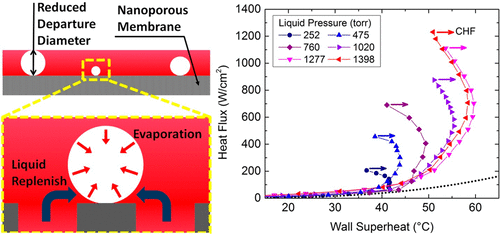当前位置:
X-MOL 学术
›
Nano Lett.
›
论文详情
Our official English website, www.x-mol.net, welcomes your feedback! (Note: you will need to create a separate account there.)
Ultrahigh Flux Thin Film Boiling Heat Transfer Through Nanoporous Membranes
Nano Letters ( IF 10.8 ) Pub Date : 2018-04-06 00:00:00 , DOI: 10.1021/acs.nanolett.8b00648 Qingyang Wang 1 , Renkun Chen 1
Nano Letters ( IF 10.8 ) Pub Date : 2018-04-06 00:00:00 , DOI: 10.1021/acs.nanolett.8b00648 Qingyang Wang 1 , Renkun Chen 1
Affiliation

|
Phase change heat transfer is fundamentally important for thermal energy conversion and management, such as in electronics with power density over 1 kW/cm2. The critical heat flux (CHF) of phase change heat transfer, either evaporation or boiling, is limited by vapor flux from the liquid–vapor interface, known as the upper limit of heat flux. This limit could in theory be greater than 1 kW/cm2 on a planar surface, but its experimental realization has remained elusive. Here, we utilized nanoporous membranes to realize a new “thin film boiling” regime that resulted in an unprecedentedly high CHF of over 1.2 kW/cm2 on a planar surface, which is within a factor of 4 of the theoretical limit, and can be increased to a higher value if mechanical strength of the membranes can be improved (demonstrated with 1.85 kW/cm2 CHF in this work). The liquid supply is achieved through a simple nanoporous membrane that supports the liquid film where its thickness automatically decreases as heat flux increases. The thin film configuration reduces the conductive thermal resistance, leads to high frequency bubble departure, and provides separate liquid–vapor pathways, therefore significantly enhances the heat transfer. Our work provides a new nanostructuring approach to achieve ultrahigh heat flux in phase change heat transfer and will benefit both theoretical understanding and application in thermal management of high power devices of boiling heat transfer.
中文翻译:

通过纳米孔膜的超高通量薄膜沸腾传热
相变传热对于热能转换和管理至关重要,例如在功率密度超过1 kW / cm 2的电子设备中。相变传热的临界热通量(CHF),无论是蒸发还是沸腾,都受到来自液-气界面的蒸气通量的限制,这被称为热量通量的上限。从理论上讲,该极限在平面上可以大于1 kW / cm 2,但其实验实现仍然难以捉摸。在这里,我们利用纳米多孔膜实现了新的“薄膜沸腾”机制,从而实现了前所未有的高CHF,超过1.2 kW / cm 2在一个平面上,该高度在理论极限的4倍之内,并且如果可以提高膜的机械强度,则可以将其增加到更高的值(以1.85 kW / cm 2演示瑞士法郎在这项工作中)。液体的供应是通过支撑液体薄膜的简单纳米多孔膜实现的,该薄膜的厚度会随着热通量的增加而自动减小。薄膜结构降低了传导热阻,导致高频气泡离开,并提供了独立的液-气通道,因此显着增强了热传递。我们的工作提供了一种新的纳米结构化方法,以实现相变传热中的超高热通量,并将在沸腾传热的高功率器件的热管理中获得理论上的理解和应用。
更新日期:2018-04-06
中文翻译:

通过纳米孔膜的超高通量薄膜沸腾传热
相变传热对于热能转换和管理至关重要,例如在功率密度超过1 kW / cm 2的电子设备中。相变传热的临界热通量(CHF),无论是蒸发还是沸腾,都受到来自液-气界面的蒸气通量的限制,这被称为热量通量的上限。从理论上讲,该极限在平面上可以大于1 kW / cm 2,但其实验实现仍然难以捉摸。在这里,我们利用纳米多孔膜实现了新的“薄膜沸腾”机制,从而实现了前所未有的高CHF,超过1.2 kW / cm 2在一个平面上,该高度在理论极限的4倍之内,并且如果可以提高膜的机械强度,则可以将其增加到更高的值(以1.85 kW / cm 2演示瑞士法郎在这项工作中)。液体的供应是通过支撑液体薄膜的简单纳米多孔膜实现的,该薄膜的厚度会随着热通量的增加而自动减小。薄膜结构降低了传导热阻,导致高频气泡离开,并提供了独立的液-气通道,因此显着增强了热传递。我们的工作提供了一种新的纳米结构化方法,以实现相变传热中的超高热通量,并将在沸腾传热的高功率器件的热管理中获得理论上的理解和应用。



























 京公网安备 11010802027423号
京公网安备 11010802027423号